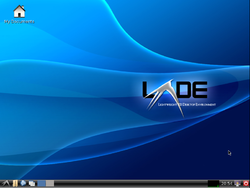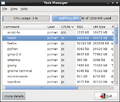Top Qs
Timeline
Chat
Perspective
LXDE
Lightweight desktop environment for Linux and BSD From Wikipedia, the free encyclopedia
Remove ads
LXDE (abbreviation for Lightweight X11 Desktop Environment) is a free desktop environment with comparatively low resource requirements. This makes it especially suitable for use on older or resource-constrained personal computers[2] such as netbooks or system on a chip computers.
LXDE was written in the C programming language, using the GTK 2 toolkit, and runs on Unix and other POSIX-compliant platforms, such as Linux and BSDs. The LXDE project aims to provide a fast and energy-efficient desktop environment.[3][4]
LXDE uses rolling releases for its individual components (or for groups of components with coupled dependencies).[5] The default window manager used is Openbox, but one can configure a third-party window manager for use with LXDE, such as Fluxbox, IceWM or Xfwm.[4] LXDE includes GPL-licensed code as well as LGPL-licensed code.[3]
Remove ads
History
Summarize
Perspective
The project was started in 2006 by Taiwanese programmer Hong Jen Yee (Chinese: 洪任諭; pinyin: Hóng Rènyù), also known as PCMan, when he published PCManFM, a new file manager and the first module of LXDE.
In 2010, tests suggested that LXDE 0.5 had the lowest memory-usage of the four most-popular desktop environments of the time (the others being GNOME 2.29, KDE Plasma Desktop 4.4, and Xfce 4.6),[6] and that it consumed less energy,[7] which suggested mobile computers with Linux distributions running LXDE 0.5 drained their batteries at a slower pace than those with other desktop environments.
Qt port
Dissatisfied with GTK 3,[8] Hong Jen Yee experimented with Qt in early 2013[9] and released the first version of a Qt-based PCManFM on 26 March 2013.[8]
On 3 July 2013 Hong announced a Qt port of the full LXDE suite,[10] and on 21 July Razor-qt and LXDE announced that they would merge the two projects.[11][12][13] This merger meant that the GTK and the Qt versions would coexist for some time but, eventually, all original team efforts focused on the Qt port, LXQt.[14]
GTK 3 port
As of May 2020, there is an experimental GTK 3 port developed by the Arch Linux community.[15] GTK 3 versions have already been developed for the following components: LXAppearance, LXAppearance-ObConf, LXDE-common, LXDE-icon-theme, LXDM, LXhotkey, LXInput, LXLauncher, LXPanel, LXRandR, LXSession, LXTask, LXTerminal, Openbox, PCManFM.[16] One advantage of using GTK 3 is that GTK 3 programs run natively on Wayland. PCManFM is a popular file manager for use with tiling window managers and hence, having a Wayland-native PCManFM is useful for people that use Sway.[citation needed]
Current development
Despite the original team moving to LXQt development, some other developers continued to maintain LXDE on GitHub and, as of March 2021, there are fresh commits to keep the GTK 2 version updated. As of July 2019, the LXTerminal release is based on GTK 3 to avoid dependencies on the old VTE lib.[17][18]
Remove ads
Availability


Default desktop
Alternative desktop
- Arch Linux[23]
- Artix Linux[24][25]
- Debian[26]
- Devuan[27]
- Fedora[28]
- Raspberry Pi OS[29][30] (later models use a heavily modified fork of LXDE called PIXEL which eventually added Wayland support, using Wayfire or labwc compositors)[31]
Former default desktop
- Lubuntu (replaced by LXQt in 2018)[32]
- Artix Linux[24][25] (now available as an alternative desktop)
- Peppermint OS (replaced by Xfce in 2022)[33]
Remove ads
Software components of LXDE
Summarize
Perspective
Unlike other major desktop environments such as GNOME, the components of LXDE have few dependencies and are not tightly integrated.[34] Instead, they can be installed independently of each other or LXDE itself.[35]
- GPicView
- LXAppearance
- LXPanel
- LXPanel Preferences
- LXTask
- PCManFM
- Autocompletion of Panel tasks
See also
- LXQt – A lightweight desktop environment and spiritual successor to LXDE
- Xfce – Another lightweight desktop environment built using GTK
- Comparison of X Window System desktop environments
References
External links
Wikiwand - on
Seamless Wikipedia browsing. On steroids.
Remove ads









